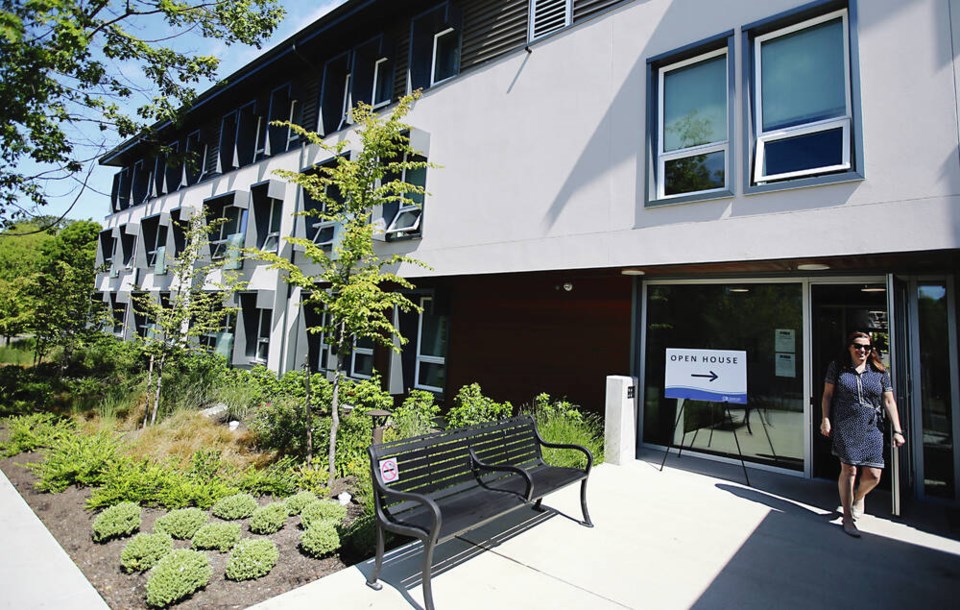Courtesy of Times Colonist
Photo: The Greater Victoria Housing Society recently held a grand opening for Townley Place, a three-storey affordable apartment building near Royal Jubilee Hospital. Trevor Hancock writes that municipalities need to expedite approval processes for much-needed social housing through measures such as pre-zoning, allowing for higher levels of density, waiving development fees and providing property-tax breaks. ADRIAN LAM, TIMES COLONIST
Last week, I introduced Livable Victoria, of which I am a member.
We are an informal and non-partisan group of people who share a passion for making our region a more sustainable, vibrant, healthy and inclusive place to live.
Our aim is to “create a city that respects our planet’s ecological limits while promoting human health and wellbeing,” which has been the focus of my work for much of the past 40 years.
This week, I will begin to explore our “Five Big Ideas” in more detail, from the perspective of human wellbeing and its achievement within the Earth’s ecological boundaries.
These ideas are intended to provide a balanced and holistic perspective and be implemented together. We want to create a city-region that puts the health of the planet and the wellbeing of everyone who lives here at the centre of decision-making about the built environment.
The first of the Five Big Ideas is to scale up and facilitate the rapid development of social housing across the region, the provision of which is essential to ensure health and wellbeing for everyone.
The Canadian Observatory on Homelessness notes “the term ‘social housing’ refers specifically to housing that is subsidized by a level of government.” It is just housing for ordinary people whose incomes are insufficient to afford market-price housing.
I addressed this issue in my April 10 column “Speeding development of non-profit housing is good for health” and won’t repeat here what I said then.
But it is important to understand that the crisis in social housing was the result of the cancellation of the federal social housing program in 1993 and the downloading of responsibility to the provinces in the early 1990s, together with the failure of incomes to keep pace with increased housing costs.
Nicole Chaland, a local housing and homelessness researcher and a member of Livable Victoria, uses data from a 2015 article that shows social housing fell from a range of seven to 20 per cent of all housing built annually between 1972 and 1994 to one to two per cent after 1996.
As a result, she notes, “Canada now has one of the most privatized housing markets of the 38 members countries in the OECD. Only 3.5 per cent of Canada’s housing stock is protected from market influences.”
The good news is that both the federal and provincial governments have finally started to act on the issue of social housing, affordability and homelessness, after decades largely ignoring the problems. But local governments have only a limited capacity to respond to the policy failures of higher levels of government.
Nonetheless, the CRD’s Housing First Program and its Affordable Housing Strategy are beginning to address the issue locally.
In partnership with the federal and provincial governments, the Housing First Program is working “to eliminate chronic homelessness and generate new rental housing options … moving at-risk individuals into long-term, tenant-based, supported housing to enable recovery and integration into society.”
So far, the construction of over 1,000 units is in planning, underway or completed; of these, 20 per cent are provincial income assistance units, 31 per cent affordable and 49 per cent near-market rental.
We believe this process could be strengthened if municipalities remove barriers to social housing and incentivize and expedite approval processes through measures such as pre-zoning, allowing for higher levels of density, waiving development fees and providing property-tax breaks.
Other useful steps can include using existing public land and acquiring new land for social housing; establishing dedicated municipal staff positions to facilitate the development of social housing; providing greater flexibility in land-use zoning for social housing, such as allowances for live-work spaces; and broadening the range of accepted design guideline considerations, allowing social benefit, community safety, and cultural features to offset other design goals.
Social housing, an important component of the affordable housing spectrum, is not just an issue for low-income people but a concern for all of us.
As the CRD notes, “affordable housing is key to a strong economy and healthy region.”
In fact a CMHC report last month found B.C needs more than half a million new affordable units by 2030. So next week I will look at our suggestions for building more affordable and sustainable housing.
thancock@uvic.ca
Dr. Trevor Hancock is a retired professor and senior scholar at the University of Victoria’s School of Public Health and Social Policy.
